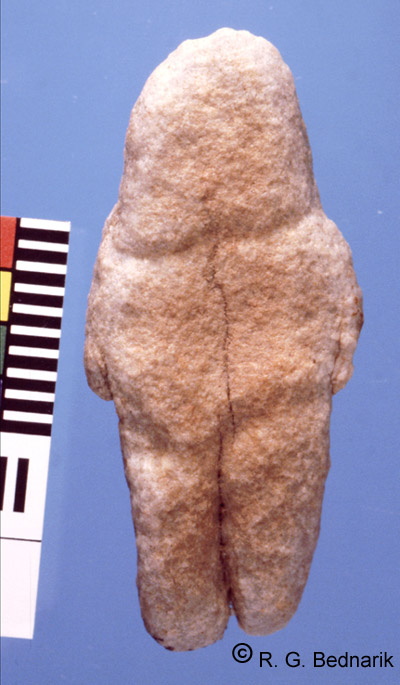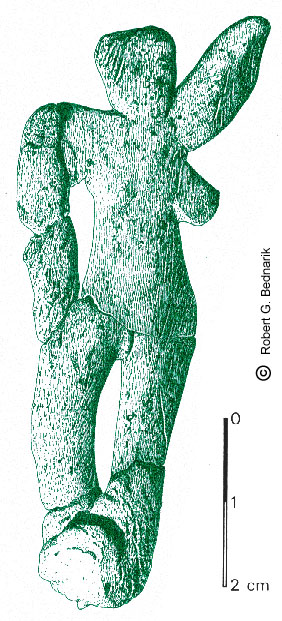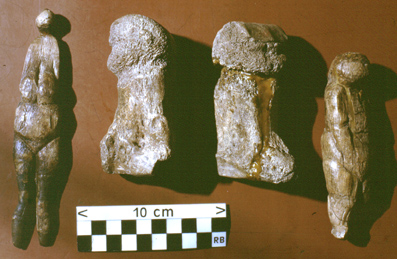Figurines and plaques
|
While palaeoart of the Lower and Middle Palaeolithic is limited to beads, pendants, pigment, certain types of manuports and a number of relatively simple engraved marks on various types of materials, figurines and more complex marked plaques only appear about 35 000 to 30 000 years ago. The above finds from Makapansgat and Berekhat Ram are not sculptures, even though in both cases some appreciation of iconic features may reasonably be inferred. In the case of the Tan Tan figurine, however, the term sculpture seems justified, even though its maker still began with a natural form (see Fig. 1).The possibly earliest known fully sculpted iconic figurine may be the presumed bear head from Tolbaga, Siberia, if the proposed dating of about 34 800 BP were correct (Bednarik 1994a). The most notable series of early sculptures comes from a number of very early Upper Palaeolithic sites in central Europe. They are the Galgenberg female figurine of serpentine, from Austria (Bednarik 1989) (Fig. 2), and finds from three German sites: the ivory therianthrope from the Stadel at Hohler Stein (Schmid 1989), a small anthropomorphous relief carving from Geißenklösterle, and several animal figurines from Vogelherd (Riek 1934, 1960). These early sculptures are iconographically sophisticated and full of expression, implying a preceding tradition of which we lack any such finds (Marshack 1985). They are followed by various Upper Palaeolithic traditions of producing anthropomorphous and zoomorphic figurines of stone, burnt clay, ivory and bone — the materials capable of surviving in adequate numbers to render the tradition archaeologically visible. The geographical distribution of these materials encompasses especially south-western, central and eastern Europe, central Siberia and the Levant.The most frequently discussed figurines of pre-History are the so-called ‘Venus’ figurines of the Eurasian Upper Palaeolithic. They have been subjected to an unparalleled attention of interpretational fervour, characterised by several common features: the interpretations are ideologically motivated, they are taphonomically naive, they are presented by inadequately informed commentators who often had not studied any of the evidence or sites first hand, and their epistemology is often appalling. The underlying idea of all of these hypotheses is that there is a corpus of some 100 to 140 female figurines, whose distribution from the Pyrenees to Lake Baikal indicates a Gravettian tradition concerned with fertility, or with a mother goddess cult, with Palaeolithic pornography or whatever other imagined cultural activity. None of these studies attempts to define the sample spatially or temporally, by stating a rationale for including or excluding specimens. All omit numerous known examples that would fall well within the stated or implied parameters of such studies. Most of the figurines in question exhibit no clear evidence of female attributes, they are not corpulent or large-breasted as frequently claimed (most have no breasts, and one male figurine also has small breasts), some appear to be fully clothed, very few might be pregnant, and fewer still could reasonably be classified as steatopygous. Most of these specimens are either undated, or they are not from a Gravettian context. Indeed, these anthropomorphous figurines originate from all periods of the Upper Palaeolithic, and some of them may be as yet undetected fakes (e.g. from Brassempouy; Bahn 1993).
To analyse an arbitrarily selected, chronologically and formally undefined, incomplete sample such as this collection is not a scientifically promising procedure. Apart from usually a priori assumptions about meaning, it is not even clear what the sample is intended to be representative of (Bednarik 1996). The sample has been defined entirely on the basis of ideological, cultural and academic conditioning of how to detect the visual clues provided by the artists of an alien culture, and by arbitrary (and invalid) variables of spatial and chronological distribution. Consequently the sample will include specimens that are 20 000 years and 6000 km apart, but it will exclude those from the very same site and only a few millennia younger (of the Holocene). It will exclude other forms of female depiction of the same period, and will perceive differences in iconography as culturally conditioned, when in fact they are more likely the outcome of technological factors (Bednarik 1990d). The analysis of a sample should not be accepted if the sample was defined by excluding those specimens that would contradict a desired finding. Hence we need to start by defining our sample without anticipating what we are going to find. Since such a definition of sample cannot be free of theory, we would do well to abandon all ideological baggage. This has not been done in the study of the figurines colloquially known as ‘Venuses’. Consequently the interpretative literature on the supposedly female figurines of the Eurasian Upper Palaeolithic, with its references-4 to fecundity and so forth, consists largely of androcentric, gynocentric, heterocentric, feminist-inspired and Eurocentric polemic. Its only relevance to fertility is that this literature would be a highly fertile area for epistemological research of heuristic dynamics in archaeology, and of how theories tend to grow, like mushrooms, in the dark. This deservedly harsh judgment does not extend to purely descriptive and ideology-free works on this material, which are rare and receive much less attention (e.g. Rosenfeld 1977; Russell 1992; Gvozdover 1997). The figurines in question are of greatly differing formal attributes, antiquities, cultural affiliations, geographic provenience and materials. Almost certainly they do not represent a homogeneous tradition, but have been lumped together by scholars seeking confirmation of preconceived explanations (Figs 3, 4). While three-dimensional iconographic art of the Upper Palaeolithic is widely found in Eurasia, the distribution of two-dimensional iconic palaeoart differs significantly. East of Germany and Italy, across all of Eurasia, Pleistocene graphic art is almost exclusively noniconic, be it portable or on rock. There are only a few exceptions (Bednarik 1995b). No explanation is available for this glaring distributional discrepancy, nor has it even attracted interest. The graphic Pleistocene art of most of Eurasia consists of ‘geometric’ designs that are often of great complexity, especially at Russian sites. Most of this palaeoart is found on plaques of stone, bone and ivory. The thousands of engraved Upper Palaeolithic plaques of western Europe, by contrast, feature a rich array of iconic markings, at such sites as Rochedane, Mas d’Azil, La Marche, Gönnersdorf and Parpalló. Engraved plaques and similar portable objects of the Pleistocene are not, however, restricted to Eurasia. While their number elsewhere is considerably smaller (Bednarik 1994a), this is at least to some degree a predictable outcome of uneven research efforts and of research biases. The point is illustrated by the remarkable concentrations of Palaeolithic palaeoart objects in the two regions that have experienced the most sustained research efforts in all of Asia, the area around Irkutsk and the Levant. Elsewhere on this huge continent, such early art objects are exceedingly rare (Bednarik 1994a). Art traditions no doubt existed, but almost none of the surviving evidence has so far been located (consider China, where only one engraved Palaeolithic object has been found; Bednarik 1992b). Australia, with its particularly rich heritage of Pleistocene rock art, has a notable absence of portable art objects of that period. The few published exceptions of early stone plaques, from Devil’s Lair and Koonalda Cave, have been rejected after specialist analysis (see elsewhere on this site). The mysterious ‘cylcons’, cylindrical-conical stone objects from eastern inland Australia, often bear engravings, and they may well be of the Pleistocene. However, no attention has been given to that issue so far.
R. G. Bednarik 2002 References for portable palaeoart |



